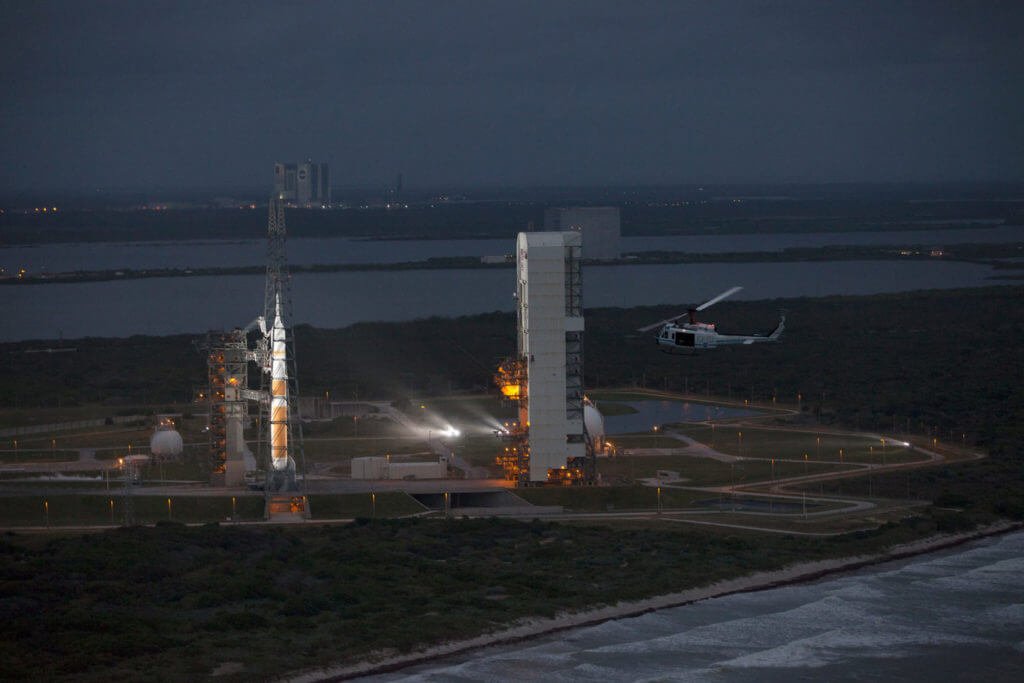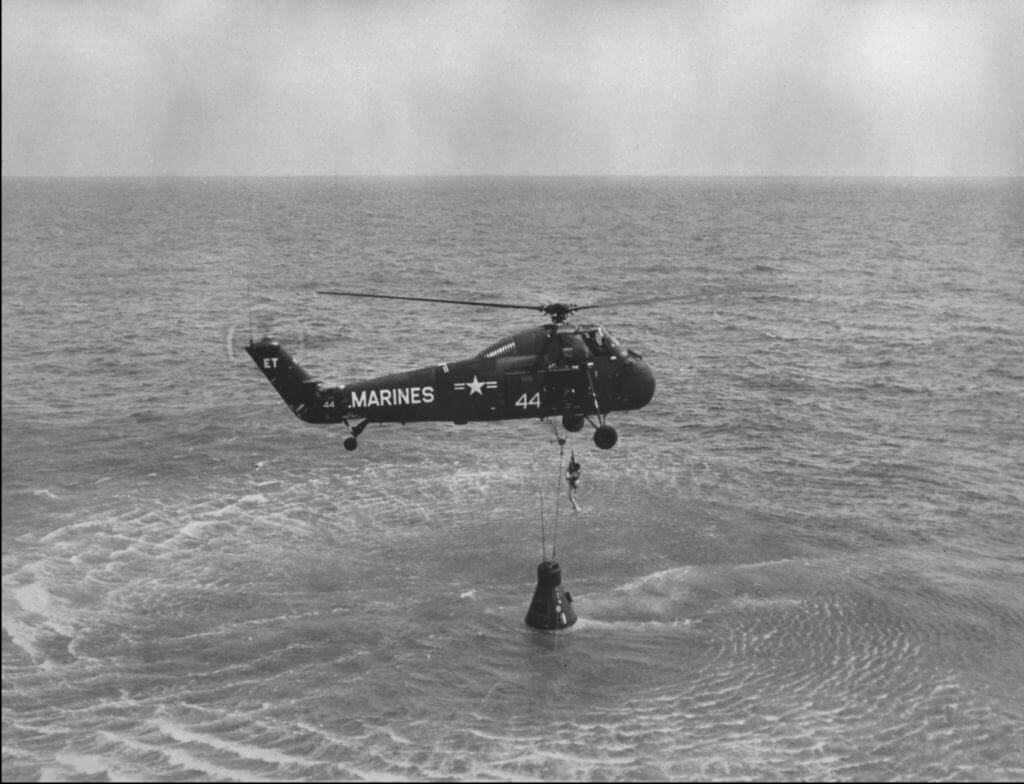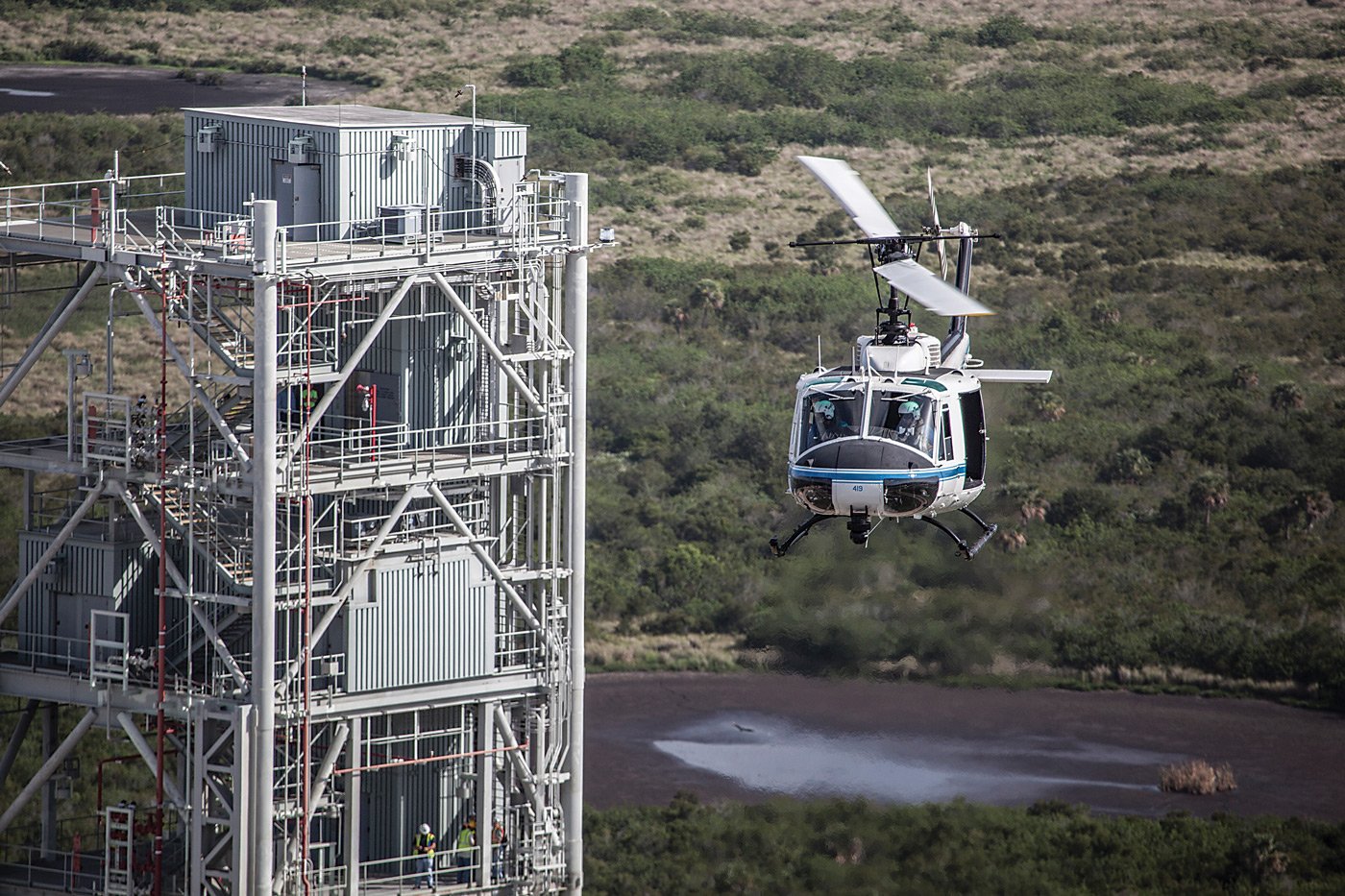The sound of an approaching Bell UH-1H Huey II helicopter echoes across the John F. Kennedy Space Center (KSC). The blue and white helicopter is a veteran of the Vietnam War, but it now wears the colors of the National Aeronautics and Space Administration (NASA) and is used to support multiple missions at Kennedy’s sprawling 220-square-mile (144,000-acre) spaceport on the north part of Merritt Island on the Atlantic coast of Florida.
The iconic center includes the massive Vehicle Assembly Building, Launch Control Center, Orbiter Processing Facility, Shuttle Landing Facility, Crawler Transporters and the historic Launch Pads 39A and 39B, where 11 manned Apollo and 135 Space Shuttle missions blasted into space. On July 8, 2011, the last Space Shuttle mission roared skyward, and the Kennedy Space Center fell silent as more than 10,000 NASA employees and contractors were made redundant.
But now, with an American space renaissance underway and more human spacecraft in development than at any time in history, Florida’s historic launch pads are in the midst of a billion-dollar upgrade to accommodate a new generation of launch vehicles and spacecraft.

And supporting those operations and technical advancements in aeronautics across the U.S. is a fleet of 59 non-spacebound aircraft and four large unmanned aerial vehicles (UAVs) from seven major centers. The diverse fleet includes Cirrus SR22 and Cessna 206H light aircraft; Beech T-34C and King Air 200, de Havilland Twin Otter, Short C-23 Sherpa, Lockheed P-3C Orion and C-130H Hercules turboprops; Gulfstream III and Dassault HU-25C business jets; Douglas DC-8 and McDonnell Douglas C-9B jetliners; Northrop T-38, Lockheed ER-2, S-3A and Martin WB-57 military jets; and Bell UH-1H helicopters.
Space Heritage
NASA was born in 1958 to lead the American effort in the space race, after the Soviet Union gained an early advantage with the launch of Sputnik — the first manmade satellite — into orbit on Oct. 4, 1957.
The new entity combined the 8,000 employees of the National Advisory Committee for Aeronautics (NACA) and its leading labs (such as Langley and Ames) with America’s top military rocket and space organizations and labs.
On May 5, 1961, the Mercury spacecraft Freedom 7 blasted off from Cape Canaveral carrying astronaut Alan Shepard Jr. — the first American in space — on a 15-minute suborbital flight, with both astronaut and capsule recovered by a Sikorsky HRS-1 (S-58) flown by Marine Air Group 26.
NASA built a new launch center at Merritt Island, north of Cape Canaveral, to accommodate the large and powerful Saturn V rockets required to send the Apollo spacecraft to the moon. On November 29, 1963, the center was renamed the Kennedy Space Center in honor of the 35th President of the United States who had just been assassinated.
Helicopter units belonging to the Department of Defense (primarily U.S. Air Force, U.S. Navy and U.S. Marine Corps) and the U.S. Coast Guard supported Mercury, Gemini and Apollo spacecraft launches and recoveries, and various contingencies.
NASA helicopters also played a small but significant role in the Apollo program. All mission commanders scheduled to fly the Lunar Module had to receive helicopter flight instruction before they could practice simulated moon landings in the Bell Aerosystems jet-powered Lunar Landing Research Vehicle. Bell 47Gs used for astronaut vertical flight training were based at Patrick Air Force Base, Florida, at Ellington Field near the Manned Spaceflight Center in Houston, Texas, and at NASA’s Flight Research Center at Edwards AFB, California.
Shuttle era
In early 1980, NASA KSC Flight Operations acquired a fleet of Army surplus Bell UH-1 Huey helicopters to support the Space Shuttle program and conventional rocket launches from pads at Cape Canaveral.
NASA’s shuttle fleet — Columbia, Challenger, Discovery, Atlantis and Endeavour — flew a total of 135 missions over 30 years. STS-1 launched on April 12, 1981, and STS-135 on July 8, 2011, with 78 flights also ending with a Kennedy landing.

NASA originally based the Hueys at Patrick AFB where they shared a hangar with modified Gulfstream II business jets that astronauts used to practice landing the shuttle “glider” on KSC’s 15,000-foot long, 300-foot wide Shuttle Landing Facility.
Launch and landing incidents were the most feared mass casualty events during the shuttle era, but non-flight related incidents when maintaining or fuelling the shuttle were considered more probable. In the event of an emergency, NASA’s rescue service vehicles included its own helicopters and Air Force Sikorsky HH-60G Pave Hawks operated by the 920th Rescue Wing at nearby Patrick AFB (see p.30, Vertical 911, Spring 2016).
Three Hueys — Search 1, Search 2, and Search 3 — were assigned specific roles during every shuttle launch, with a fourth Huey as backup.
Search 1 flew emergency response team (ERT) sharpshooters on security sweeps checking areas inaccessible to KSC’s road and water patrols. On launch day, the armed Huey escorted the Astrovan that carried the Shuttle to launcher, then guarded the site on orbit right up to the moment the Shuttle’s three engines and two solid booster rockets ignited with a deafening 7.8 million pounds of thrust.
Search 2 was on medevac alert at the Occupational Health Facility helipad with a flight surgeon and two paramedics ready to evacuate injured NASA workers and visitors to Florida hospitals.
Search 3 was based at a heliport next to the Shuttle pad with the crew on high alert to forcefully intercept any unwelcome land, sea or air intruders during the 72 hours prior to launch. This Huey was equipped with M240D machine guns mounted in each rear cabin door, and it departed the helipad 15 minutes before launch time to secure the site.
Prior to every launch, Air Force helicopters helped clear restricted areas offshore and were on standby to fly astronaut medevacs and search-and-rescue (SAR) for an aborted launch.
Shuttle landings were less intense, with two NASA UH-1s used to sweep runway approach routes in both directions and then on SAR standby in case the shuttle landed off runway or ran off the runway. If a landing accident occurred, Search 1 became the command and control aircraft for all KSC rescue assets.
Helicopter crews regularly practiced flying first responders to inaccessible areas and supporting the hazmat crews needed to contain the hazardous fluids and fuels found on the shuttle.
About a million spectators viewed the last three shuttle launches. The Hueys helped clear the large post-launch crowds by flying traffic officers from local sheriff’s departments.
Bringing in the Huey IIs
The UH-1Bs were replaced by larger UH-1Hs in the early 1990s and by more powerful UH-1H Huey IIs in 2008, when NASA took delivery of three aircraft modified by US Helicopter (now Bell) at Blackwell Field Airport in Ozark, Alabama.
The mid-1970s era U.S. Army UH-1Hs received new commercial main and tail rotor hubs, blades components, and tail booms, combined with a 1,800-shaft-horsepower Honeywell T53-L-503 engine to provide increased hover performance in hot conditions.
“The UH-1 Huey is the most versatile [helicopter] ever made, and there is no mission that our helicopters can’t do,” said Kevin Hurd, maintenance manager for NASA’s helicopter unit.

The unit moved from Patrick Air Force Base to the Reusable Launch Vehicle building at the Shuttle Landing Facility, and today shares the hangar with Starfighters Inc., a Florida company that flies a growing fleet of supersonic Lockheed F-104 Starfighter jet fighters for flight research and suborbital payload work.
The helicopter operations and maintenance contract used to fall under NASA’s large Institution Service Contract, but in October 2015 it became a separate $7-million, five-year fixed-price contract managed by AECOM subsidiary URS Federal Technical Services Inc.
Today, NASA employs three helicopter pilots (the chief of ops, safety pilot and a pilot who divides their time between flight ops and UAS operations), a maintenance director, and contracts nine people, including three pilots, three mechanics, an inspector, and a stores man and administrator from URS.
All three NASA Huey IIs were upgraded in early 2016 by Sarasota Avionics in western Florida with a new touchscreen Garmin GTN 750 integrated GPS/NAV/COMM that will provide the NASA pilots with greater situational awareness and ensure the aircraft meets ADS-B requirements.
For the latest Huey II upgrade, the KSC drew on the technical aircraft expertise of the team at the Johnson Space Center in Houston to upgrade the helicopter cockpits with BAE lightweight, crashworthy pilot seats.
Kennedy’s three Huey IIs perform security patrols, medical evacuation, wildfire firefighting, and assist environmental experts in keeping track of local wildlife at the Merritt Island National Wildlife Refuge. The aircraft fly about 300 hours a year.
“Our main helicopter mission, past and present, is flying security patrols of the Kennedy Space Center,” explained Dave Ramsey, NASA KSC’s chief of flight operations. Ramsey spent 21 years in the U.S. Army, mainly piloting, instructing and managing Boeing CH-47 Chinooks in Europe and Airbus UH-72 Lakotas and Sikorksy UH-60 Black Hawks at Fort Belvoir, Virginia. “Obviously working for NASA is a special honor. I grew up watching the Shuttle launches and I now find myself working alongside former Shuttle commanders.”
For the security patrols, the unit flies with members of the site’s large emergency response team, “who can provide a strong and highly visible armed year-round response to any potential intruders,” said Ramsey.
When the shuttle program ended, the ERT shifted its training focus to workplace safety, and threats like active shooters, hostage takings or a terrorist.
Joint ERT training includes practicing a number of scenarios, including missions where team members perform fast-rope exits from the helicopter over land and hover jumps over the water. The NASA helicopters don’t have hoists, but this equipment is on the unit’s wish list.
In 2015, all the KSC helicopter pilots were qualified with night vision goggles (NVGs), increasing the unit’s safety margins and allowing it to fly at night at altitudes of less than 500 feet.

The 140,000-acre Merritt Island National Wildlife Refuge overlaps with the Kennedy Space Center, and provides a wide variety of habitats hosting more than 1,500 species of plants and animals and 15 federally listed species. Part of the helicopter unit’s remit is to support environmental operations in the refuge.
“Once a month we also fly scientists from the U.S. Fish and Wildlife Service to the Merritt Island National Wildlife Refuge, which overlaps with the space center, for wildlife surveys that include bald eagle, alligator, and manatee counts,” said Ramsey, adding that “the flying is more intensive in nesting and migratory bird season.”
Florida receives a lot of lightning strikes, and in 2000 the Hueys were equipped with SEI Bambi Buckets to fight fires for the U.S. Fish and Wildlife Service in the Refuge, as well as on NASA property.
As the helicopters are considered national assets, they have been tasked to respond to other natural disasters in Florida, such as hurricanes and wildfires.
Expanding multi-user spaceport
Prior to 2012, the Kennedy Space Center was fully dedicated to NASA programs, but was suffering from diminished government funding. A fresh approach was needed to transition Kennedy from a monolithic NASA facility to a multi-user spaceport, where private companies could develop innovative new launch systems more efficiently and affordably than a government bureaucracy.
Today, if you fly over the Space Coast in a Huey II, you will see nine launch pads — three at Kennedy and six at Cape Canaveral — being refurbished or used by NASA, the Department of Defense and commercial space companies for International Space Station (ISS) resupply missions, commercial satellite launch missions, and U.S. government science and national security missions.
In 2008, NASA contracted spacecraft developed by two private spaceflight firms — the SpaceX Dragon and Orbital ATK Cygnus — to fly low earth orbit cargo missions to the ISS.
Elon Musk’s SpaceX leased Cape Canaveral’s Launch Complex 40 and KSC’s historic pad 39A, and in 2012 started flying cargo to the ISS using the Falcon 7 rocket and Dragon spacecraft, and Orbital ATK started cargo flights from Cape Canaveral and the Mid-Atlantic at Wallops Island, Virginia.
In January 2016, NASA contracted Sierra Nevada Corporation’s Dream Chaser spaceplane to be a third cargo supplier to the ISS. The Dream Chaser glides back to Earth and lands on a runway like the NASA Space Shuttle. During early unmanned test flights, the Dream Chaser was hoisted aloft by an Erickson S-64 Aircrane high above Edwards Air Force Base in California and released to glide back to the base runway. For the most recent glide test in 2017, the aircraft was dropped from a Columbia Helicopters 234.

NASA’s Commercial Crew Program will soon see the resumption of manned space flight at Kennedy carrying astronauts to the International Space Station. These flights will be performed by the commercial SpaceX Dragon capsule and Falcon 9, and Boeing CST-100 capsule and Atlas V.
“We will be developing new security and medevac procedures as we get closer to commercial crew launches later this year,” said Ramsey. “There will be a much more heightened ops tempo and full force training.”
NASA expects that the launch companies will contract more helicopter time as human launches from American soil resume after seven years.
“We are happy to support any one of NASA’s space partners,” added Ramsey.
The private cargo and crew contracts allow NASA to concentrate its resources on the development of the Space Launch System (SLS) and Orion spacecraft, which are designed for long duration, deep space missions to near-Earth asteroids and Mars.
The first non-crewed launch of the SLS — named Exploration Mission-1 — is now expected in 2020.
Kennedy is also seeking new partners to use its 15,000-foot-long shuttle runway and restricted air space for spaceplane and unmanned aerial vehicle (UAV) flight testing.
Advanced flight research
Over the years, NASA has operated a significant fleet of rotorcraft — including helicopters, tilt-wings and tiltrotors — and the achievements of its Langley Research Lab in Hampton, Virginia, were recognized by the Vertical Flight Society (formerly known as AHS International) in 2014, when it designated the lab a Vertical Flight Heritage Site.
Today, NASA has one Bell UH-1H based at Langley, which is currently inactive, but has been used for flight research projects and to support rocket launch activity at NASA’s Wallops Flight Facility and the adjacent Mid-Atlantic Regional Spaceport at Wallops Island, Virginia.
The Langley UH-1H has also been used to flight-test NASA’s Autonomous Landing Hazard Avoidance System (ALHAT), which will allow spacecraft to automatically land, precisely and safely, on the surface of another planet.
The self-contained ALHAT system was attached to the belly of the high-skid UH-1H and flown over test areas at Langley and Kennedy, where it analyzed terrain data acquired by three different laser sensors — a flash lidar, Doppler lidar, and high altitude laser altimeter — to determine the most suitable and safe landing sites.
NASA believes helicopters can also use the ALHAT to automatically land safely in low visibility conditions, such as brownouts.
And on May 11, 2018, NASA announced that it will develop a small unmanned helicopter to explore the surface of Mars.

“The Mars Helicopter, a small, autonomous rotorcraft, will travel with the agency’s Mars 2020 rover mission, currently scheduled to launch in July 2020, to demonstrate the viability and potential of heavier-than-air vehicles on the Red Planet,” said NASA.
The Mars Helicopter project started in August 2013 as a technology development project at NASA’s Jet Propulsion Laboratory. The result of the team’s four years of design, testing and redesign weighs in at a little under four pounds (1.8 kilograms). Its fuselage is about the size of a softball, and its twin, counter-rotating blades will bite into the thin Martian atmosphere at almost 3,000 rpm — about 10 times the rate of a helicopter on Earth. Mars 2020 will launch on a United Launch Alliance Atlas V rocket from Space Launch Complex 41 at Cape Canaveral Air Force Station in Florida, and is expected to reach Mars in February 2021.
At the Kennedy Space Center two modes of vertical flight — helicopters and rockets — have shared the airspace for more than 35 years. The evolution of the site into a multi-user spaceport will require the continual support of helicopters in the decades to come.






It will be really exciting – can’t wait……
I think you may have a misprint here. The Honeywell T53-L-503 engine should be the T53-L-703 engine. The -703 engine was the Cobra engine. I never heard of the -503 engine but I’ve been out of the industry now for 6 years so I could be wrong.
I agree Herb, they just made a typo. The Bell Huey II website even states that the Huey II conversion includes the -703 engine.
http://www.bellflight.com/commercial/bell-huey-ii